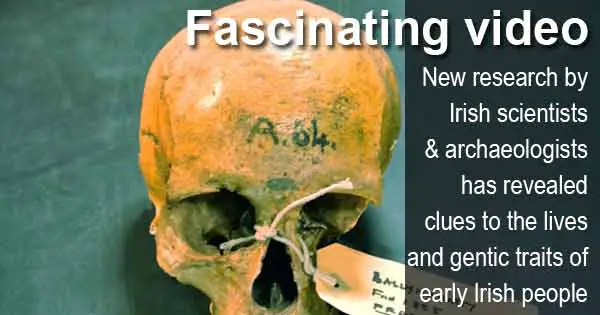Research by scientists and archaeologists at some of Ireland’s top universities has begun to reveal aspects of the lives and genetic traits of early Irish people.
The scientists of Trinity College Dublin (TCD) and archaeologists at Queen’s University Belfast have studied the bodies of three Bronze Age men who were buried on Rathlin Island – off the coast of Co Antrim – around 4,000 years ago.
They found presence of genetic traits that suggest the men had high lactose tolerance.

Dan Bradley, professor of population genetics at TCD said: “Lactose tolerance suggests that we have a long history of strongly relying on milk as a major food source, rather than simply meat from livestock.”
There have been some big strides forwards in the field of genetic studies in recent years which gives us a better understanding of where Irish genetic traits come from.
It was already widely accepted that farming began around 5,800 years ago. Now new research of the genetic code of a woman who was buried south of Belfast has given clues as to how farming may have started in Ireland.
Her body was first excavated in 1855 and it was established that she was a farmer.
Now after analysing her remains, researchers have produced a genome which is a code that is made up of 3bn parts and makes every human unique.
Prof Bradley said: “The genome sequencing process has been mainly for medical purposes, but we have piggy-backed the technology [which] medical people have developed.”
The woman lived around 5,200 years ago. Farming had begun centuries earlier. Her genome showed that she had dark hair and brown eyes. This along with other genetic traits revealed that the woman’s ancestry was from the Middle East, where agriculture had begun.
The subject of agriculture has been controversial in the past with some believing that local Irish people developed their own farming methods independently.
However, the findings which have been published in the journal Proceedings of the National Academy of Sciences, USA, show that there would have been significant migration from the east.
The genomes of the more recent Bronze Age men from Rathlin Island – around 4,000 years old – revealed that a third of their genetic ancestry had come from a region near the Black Sea and modern Ukraine and Russia.
Prof Bradley said that this shows how much people travelled during the Bronze Age.
He said: “There was a great wave of genome change that swept into Europe from above the Black Sea into Bronze Age Europe and we now know it washed all the way to the shores of its most westerly island.
“This degree of genetic change invites the possibility of other associated changes, perhaps even the introduction of language ancestral to western Celtic tongues.”
The genomes of the Bronze Age men showed genetic traits for the disease haemochromatosis which causes high retention of iron in the blood.
Today Irish people have the world’s highest levels of this genetic variant – so much so that it is known as the Celtic curse – so the discovery of the disease in the Bronze Age men helps us to further understand the origins of the Irish gene pool.
Lara Cassidy, a PhD genetics researcher at TCD said: “Genetic affinity is strongest between the Bronze Age genomes and modern Irish, Scottish, and Welsh, suggesting establishment of central attributes of the insular Celtic genome some 4,000 years ago.”
More history articles
The Neolithics – first people to leave their mark on Ireland
Ireland Calling Videos
Check out the Ireland Calling YouTube Channel for more great videos like
